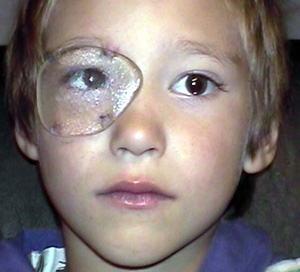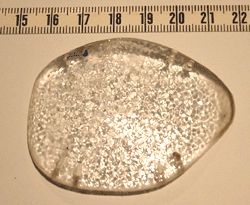
Patient during 4-weeks of protective, amblyopia therapy with Transluscent Shield occluder fashioned out of plastic shower stall window.
Manufacture of a Shield Occluder
Manufacture of the shield occluder: Shield occluders were manufactured from heat-moldable plastic according to each patient’s face and MTI® 1:1 Polaroid photographs. Four pairs of holes were drilled in the edges for attachment by sutures. Shield occluders can be opaque and black with holes drilled perpendicular to the visual axis for ventilation and possible irrigation . A threaded brass screw was placed in the middle to allow intermittent acuity check of the better eye. The second edition of the shield occluder was fashioned from translucent material resembling the Spielman Occluder® (Precision Vision, La Salle, Illinois). Fracture resistant, plastic, shower-stall windows were cut according to predetermined shape for right and left eyes and 4 sets of two holes were drilled for suture attachment. The translucent occluders did not need ventilation or threaded brass viewing holes because the occluded eye was easily viewed by ophthalmologists and parents. Acuity through the shower-stall window moldable plastic material was reduced from 20/20 to 20/4000. A local optician should be able to manufacture shield occluders to custom fit amblyopic patients.
Selection of suture material: We sought to minimize scarring while allowing the shield occluder to remain over the better eye for several weeks. After consulting several local facial plastic surgeons, pediatric surgeons and the oculoplastic surgeon, we also discussed long term skin penetration and foreign body toleration with a reputable, licensed body piercer. Then a prototype shield occluder was fashioned, heat molded and drilled and sewn to one investigators non-dominant forearm by the other investigating surgeon. We used one 4-0 nylon monofilament suture, one 3-0 monofilament prolene suture and two large surgical staples with 4-0 braided silk thread passing through the resultant rectangle-shaped staples and tied through the occluder holes. This prototype occluder was tolerated for more than five weeks without resultant infection; after the first ten days, we enhanced fixation by taping. Of the three attachment types, the 3-0 Prolene was best tolerated. The rectangular shape of the surgical staples was less ideally tolerated than round stainless steel rings (sold by body piercers) due to indirect tugging by the 4-0 silk sutures.
